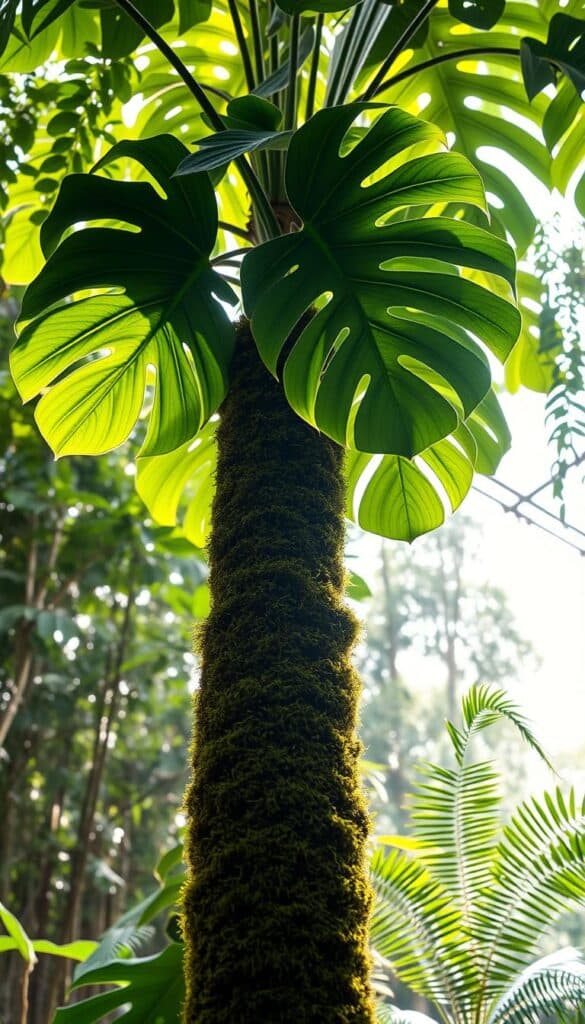There’s something truly magical about bringing a piece of the rainforest into your home, and the Monstera Pinnatipartita is no exception. Native to Central and South America, this rare, climbing evergreen captivates with its deeply fenestrated, heart-shaped leaves that seem to tell a story of their own. My journey with this plant began with excitement and curiosity, and it’s been a rewarding adventure ever since.
While it may boast a show-stopping appearance, the Monstera Pinnatipartita is surprisingly easy to care for. With bright, indirect light and proper attention, it can thrive indoors, growing up to 2 feet each year. One of the most thrilling aspects is watching it transform from juvenile leaves to the mature, fenestrated beauty it’s known for. Patience is key, but the payoff is well worth the wait.
Though it’s a stunning addition to any room, it’s important to note that this plant isn’t pet-safe due to its toxic compounds. In the following sections, I’ll guide you through the essentials of caring for your Monstera Pinnatipartita, from propagation to providing the right support. With the right conditions, you’ll find that nurturing this plant is not only manageable but also deeply rewarding.
Key Takeaways
- The Monstera Pinnatipartita is a rare evergreen native to Central and South America.
- It requires bright, indirect light and proper care to thrive indoors.
- This plant can grow up to 2 feet annually and becomes a focal point as it matures.
- Patience is needed as it transitions from juvenile to mature, fenestrated leaves.
- While beautiful, it’s not pet-safe due to toxic compounds.
Getting Started with Monstera Pinnatipartita Care
Starting your journey with the Monstera Pinnatipartita begins with the basics—choosing the right spot and selecting the perfect pot and soil. These foundational steps set the stage for healthy growth and thriving beauty.
Choosing the Right Location
Lighting is key. Place your plant near an east-facing window for bright, indirect light. Avoid direct sunlight to prevent leaf scorch. If an east-facing window isn’t available, a north-facing window with grow lights works well. This setup ensures your plant gets the light it needs without overexposure.
Selecting the Proper Pot and Soil
Your pot should have drainage holes to prevent waterlogged soil and root rot. Opt for a well-draining soil mix—either a pre-made monstera or aroid blend, or a custom mix of orchid bark, vermiculite, and coco coir. This blend retains moisture but drains excess water, keeping roots healthy.
A well-balanced pot and soil combination is crucial for vigorous growth.
| Soil Component | Benefits |
|---|---|
| Orchid Bark | Improves drainage and aeration |
| Vermiculite | Retains moisture, prevents drying out |
| Coco Coir | Enhances water retention and root health |
Regularly check soil moisture by gently probing the top inch. This simple habit ensures optimal conditions for your plant. Starting right sets your Monstera Pinnatipartita up for success, even if you’re new to plant care.
Essential Light, Water, and Humidity Tips
Creating the perfect environment for your plant involves balancing light, water, and humidity. These elements are crucial for healthy growth and preventing common issues.
Achieving Bright Indirect Light
Place your plant near an east-facing window for ideal bright, indirect light. Avoid direct sunlight to prevent scorching the leaves. If natural light is insufficient, consider using grow lights to supplement. Remember to rotate the plant regularly for even growth.
Maintaining Optimal Humidity Levels
Your plant thrives in humidity above 50%. Use a humidifier or place the pot on a pebble tray filled with water. Another option is situating it in a bathroom with steam. This helps maintain the right moisture levels without overhumidifying.
Watering Practices to Prevent Root Rot
Water only when the top inch of soil feels dry. Use a moisture meter for accuracy. Ensure the pot has good drainage holes to prevent waterlogged soil. Proper watering and drainage are key to avoiding root rot and fostering healthy growth.

Propagation and Pruning Strategies
Propagation and pruning are essential skills for any plant enthusiast. These techniques not only help in multiplying your plants but also keep them healthy and thriving.
Propagation Techniques for New Growth
Starting new plants from stem cuttings is an exciting process. Take a 4- to 6-inch cutting just below a leaf node using clean, sharp shears. This ensures a clean, sterile cut. Dip the cut end in rooting hormone to boost growth. Place the cutting in a moist, well-draining medium or water, and wait 2-3 months for roots to develop. Once roots form, transfer the cutting to a larger pot for continued growth.
During this process, remove any excess foliage from the base of the stem. This focuses the plant’s energy on root development. Proper care during these initial months is crucial for successful propagation.
Trimming and Pruning for Plant Health
Regular pruning is vital for maintaining your plant’s health and appearance. Use sharp shears to remove damaged or overcrowded leaves. This helps prevent disease and encourages vigorous growth. Pruning also controls the plant’s height and shape, keeping it aesthetically pleasing.
Monthly pruning can help manage the plant’s size while preserving its natural beauty. By trimming strategically, you ensure your plant remains in excellent condition and continues to thrive.
| Tool | Purpose |
|---|---|
| Sharp Shears | For clean cuts and pruning |
| Rooting Hormone | Boosts root development |
| Moist Medium | Supports cutting growth |
Support Structures and Long-Term Maintenance
As your Monstera Pinnatipartita matures, providing the right support becomes essential. This is where tools like moss poles and trellises come into play, offering more than just structural aid—they also enhance nutrient absorption for healthier growth.
Using a moss pole is one of the best ways to support your plant. The moss covering the pole acts like a sponge, holding moisture and nutrients that the plant can absorb through its aerial roots. This not only promotes robust growth but also keeps the plant upright, preventing droopy stems.

Regular maintenance is key to long-term health. Wipe leaves with a damp cloth to remove dust and prevent pests. Fertilize during the growing season with a balanced fertilizer, and use a humidifier to maintain optimal moisture levels. These practices ensure your plant stays vibrant and thriving.
Repotting every year or two is also crucial. It gives the roots room to grow and refreshes the soil. Check for pests like mealybugs or spider mites, and treat them early with organic remedies. By combining proper support with consistent care, your Monstera Pinnatipartita will remain a stunning, healthy addition to your home.
Conclusion
With consistent care and attention to detail, your plant will flourish throughout every season, from the active growing season to the quieter winter months. Remember to check the top inch of soil moisture regularly and adjust your watering schedule as the level of humidity in your home changes.
Proper care practices like propagation, pruning, and using support systems will keep your plant healthy and vibrant. By maintaining balanced water and humidity levels, you create an ideal environment for robust growth. Regularly inspecting each leaf ensures early detection of potential issues, allowing for prompt solutions.
Take a moment to appreciate the journey of nurturing this stunning plant. Share your experiences and tips in the comments below—I’d love to hear about your successes and challenges!
